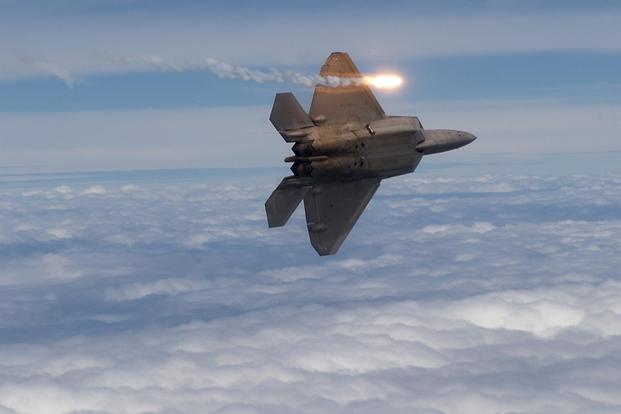The U.S. Air Force is not using its F-22 Raptor to the stealth fighter's full potential due to maintenance challenges and fewer opportunities for pilot training, as well as the inefficient organizational structure of the fleet, according to the Government Accountability Office.
In a new report released Thursday, the GAO said the F-22 will continue to suffer if Air Force Secretary Heather Wilson does not address these problems.
"[The] Air Force may be forgoing opportunities to improve the availability of its small yet critical F-22 fleet, and support combatant commander air superiority needs in high threat environments," officials said in the report.
The GAO interviewed Defense Department and Air Force personnel, who explained that the 186-aircraft fleet is stifled by a number of factors.
Related content:
- Boeing Pitches 'F-15X' Fighter Concept to US Air Force: Report
- Did the Air Force Dash Hopes for Building More F-22s?
- The F-22 Fighter Jet Restart Is Dead: Study
"Maintaining the stealth coating on the outside of the aircraft is time consuming and significantly reduces the time F-22s are available for missions," the GAO said of the maintenance and supply issues.
The way units are structured hinders not only this maintenance supply, but pilot training, the watchdog agency added.
For example, the Air Force, which last conducted an F-22 organizational review in 2010, chose to divvy up the fleet into smaller units, or "18 or 21 primary mission aircraft per squadron and one or two squadrons per wing," according to the report.
"Traditional fighter wings have three squadrons per wing with 24 aircraft in each squadron, which creates maintenance efficiencies because people, equipment, and parts can be shared," the report said.
As a result, there is an imbalance of personnel and resources when units deploy.
When it comes to training, F-22 pilots are not meeting annual minimum requirements to stay ready for advanced air superiority missions, the GAO said.
Part of the reason is the F-22 is limited in how it performs so as not to expose the fifth-generation fighter's combat secrets when training with partner or allied forces.
"F-22 pilots may be restricted from flying the F-22 the way they would fly it in combat -- due to security concerns about exposing the F-22's unique capabilities," the report said. "These restrictions limit the value of the exercises and can result in pilots developing bad habits, according to Air Force officials."
Another issue is location. F-22 pilots aren't getting their air-to-air superiority training in for the next high-end fight because they're busy at home stations in Hawaii and Alaska sitting alert to intercept military or civilian aircraft encroaching into U.S. airspace.
"Pilots and aircraft assigned to the alert mission cannot be used for any other purposes, including training," the GAO said.
Pilots told Military.com last year these limitations were likely to get worse, and therefore the service was likely to turn elsewhere for extra help.
For example, the Air Force has long looked to outsource a significant amount of its "red air," or adversary air, training for its combat forces. The move would mean time better spent for airmen who need more practice to beat the adversary, especially going forward in a near-peer fight.
The Air Force originally wanted at least 381 Raptors. Had the service acquired that many of the stealthy twin-engine fighters from Lockheed Martin Corp., life now might be somewhat less hectic for the service members who fly and maintain them, according to airmen at Tyndall Air Force Base, Florida.
"To make a really good F-22 pilot, I need about seven to eight years to get him to where he is fully employing a jet and can actually quarterback the whole fight," Air Force Lt. Col. Daniel, who asked that only his first name be used, said in an interview at the F-22 base last year.
A larger F-22 fleet could "mitigate [operations] tempo, and we're always on the road. So if we had more Raptors, there'd be more Raptor squadrons, more Raptor maintainers that would mitigate some training and operational demands," he said.
The GAO said time is of the essence if the service wants to keep F-22s flying longer and pilots in the cockpit regularly.
The agency suggests Wilson look into a number of solutions to include:
- Consolidating the fleet into larger squadrons and/or wings for a higher aircraft availability rate.
- Redesigning the deployable unit schedule in squadrons to better support current deployments and future operations.
- Removing the F-22 from exercises or reducing exercise events that do not help pilots retain high-end air superiority training.
- Increasing red-air training so pilots can use their available sorties to conduct high-end training.
- Finding alternatives to using F-22 units for the alert mission, as well as other missions that do not require the air-to-air superiority fighter.
Officials said DoD officials are reviewing the findings and will take appropriate action as seen fit.
But the message is clear: "Unless the Air Force takes steps to assess and make necessary adjustments to the current organization and use of its F-22s, F-22 units are likely to continue to experience aircraft availability and pilot training rates that are below what they could be," the GAO said.
-- Oriana Pawlyk can be reached at oriana.pawlyk@military.com. Follow her on Twitter at @Oriana0214.












